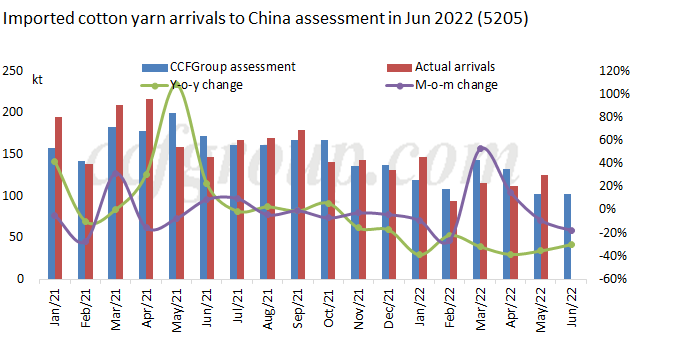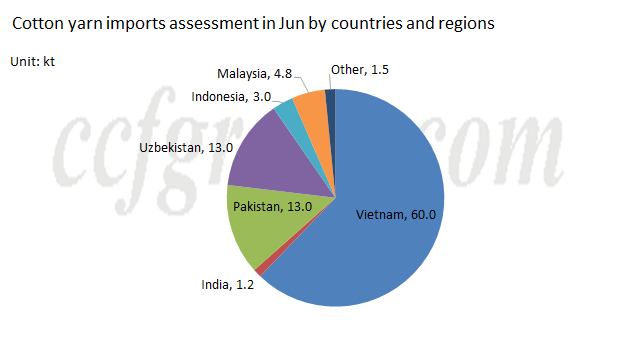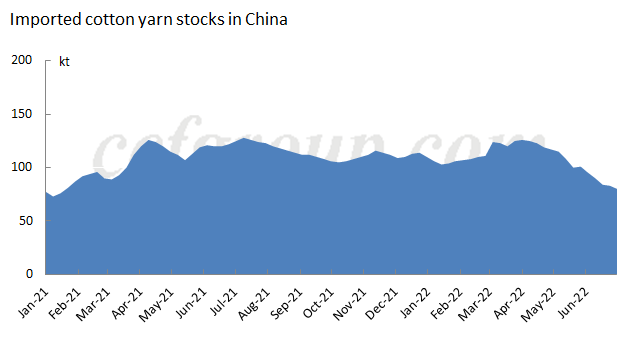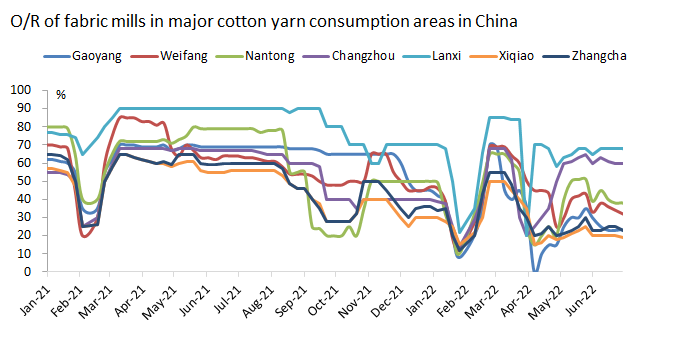Jun’22 cotton yarn imports may move down 17.6% m-o-m to 102.5kt
1. Imported cotton yarn arrivals to China assessment

According to May export data of major cotton yarn import origins and initial research of cotton yarn arrivals of China, Jun cotton yarn imports of China is estimated at 102.5kt, down 30.08% on the year and down 17.6% on the month. The orders were mostly placed in mid- to late Mar and delivered in May, with a few deliveries delayed to Jun. After mid- to late Mar, as international cotton price moved up further and the exchange rate of US dollar against RMB ascended, many traders reduced or canceled ordering plans temporarily, so Jun arrivals of imported cotton yarn will be much less than May ones.
In import origins terms, Jun yarn exports released by Vietnam Customs was over 140kt, and of it about 60kt flowed to China, down about 17.8% on the month, but it will still take up the most shares of China’s cotton yarn imports. Indian cotton yarn price rocketed from Apr affected by Indian cotton price and higher cost of exchange rate, so the arrivals to China are assessed at a record low of 1,200mt. May yarn exports of Pakistan inched up to 27kt, and those to China in Jun are expected to rise slightly to 13kt. Uzbekistani cotton yarn arrivals to China performed well in the first half year. Its offers were relatively lower and the quality improved somewhat. On the other hand, overall delivery period of Uzbekistani cotton yarn was long and some orders were settled with full payment, so it was little influenced by the rise of exchange rate. Therefore, Jun arrivals of Uzbekistani cotton yarn to China are expected to be high at about 13kt.

2. Imported cotton yarn stocks

May cotton yarn arrivals were at a high level in recent months, and the high cost strengthened the price in China market. When slack season came in Jun, the trading sentiment got paled. The lower prices of Chinese cotton yarn squeezed the market of imported cotton yarn, and the reduced orders for autumn and winter also hindered the trades. As a result, the stocks of imported cotton yarn were reduced more slowly. At present, the total stocks of imported cotton yarn were assessed at about 80kt.
3. Downstream operating rate
The operating rate of weavers mainly using imported cotton yarn has been revising down since Jun. Despite eased control on the pandemic, the shrinkage of export orders in the first half year and the sharp contraction of apparel consumption in China local market toughened the operation of downstream fabric mills. In the future, the sales of imported cotton yarn still face challenges. Take Lanxi as an example. The inventory of local fabric mills has averaged at over two months, and still in accumulation. If the inventory is consumed at a low speed later and restrains the demand for cotton yarn, the shortage of orders will spread all around. As the peak of electricity usage comes, downstream weavers increasingly cut or suspend production.

In conclusion, the cotton yarn to China from major origins shows a downtrend in shares of their total exports, indicating that it turns less popular after losing price advantages. In the first half of 2022, China’s cotton yarn imports amounted to about 700kt. The traders curtailed the stocks of imported cotton yarn and made it only 1/3 of that in the same period last year, which also supported the price. However, the strength could not last long under short demand. Recently, as cotton price plunges, ordering opportunities appear again. Thus Jul and Aug arrivals of imported cotton yarn are expected to increase much. On the other hand, the depreciation of current stocks also urges the traders to lower prices for sales.
- Top keywords
- Cotton Price
- Cotton Futures Price
- Cotton Futures
- CZCE
- PTA Futures Price
- Chemical Fiber
- Polyester Prices
- Wool price
- PTA Futures
- Shengze Silk
- China
- Yarn Price
- price
- China Textile City
- Fibre Price
- Benzene Price
- Cotton
- Index
- Cotton Index
- PTA
- fabric price
- NYMEX
- Top 10
- textile industry
- Spot Cotton
- Cotton Yarn
- Polyester Price
- Futures
- PTA Price
- cotton yarn price

